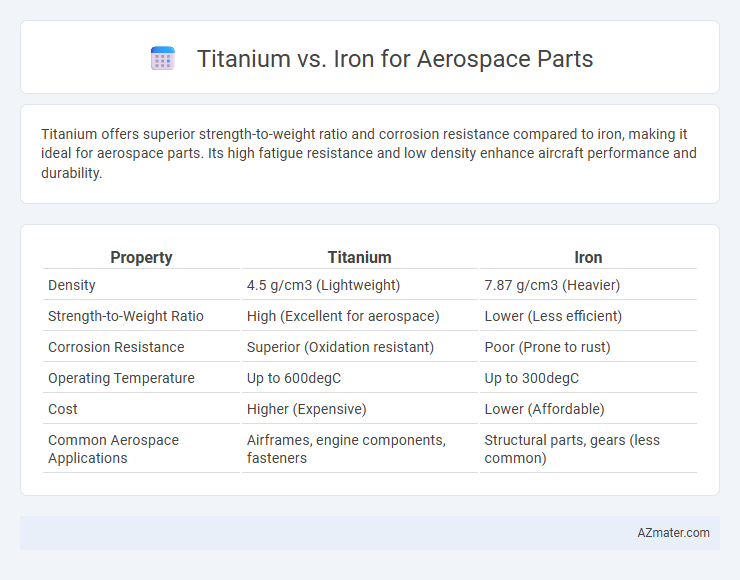Titanium offers superior strength-to-weight ratio and corrosion resistance compared to iron, making it ideal for aerospace parts. Its high fatigue resistance and low density enhance aircraft performance and durability.
Table of Comparison
| Property | Titanium | Iron |
|---|---|---|
| Density | 4.5 g/cm3 (Lightweight) | 7.87 g/cm3 (Heavier) |
| Strength-to-Weight Ratio | High (Excellent for aerospace) | Lower (Less efficient) |
| Corrosion Resistance | Superior (Oxidation resistant) | Poor (Prone to rust) |
| Operating Temperature | Up to 600degC | Up to 300degC |
| Cost | Higher (Expensive) | Lower (Affordable) |
| Common Aerospace Applications | Airframes, engine components, fasteners | Structural parts, gears (less common) |
Introduction: Significance of Material Selection in Aerospace
Material selection in aerospace critically influences performance, safety, and cost, with titanium and iron being prominent choices due to their distinct properties. Titanium offers superior strength-to-weight ratio, corrosion resistance, and high-temperature stability essential for aerospace components exposed to extreme conditions. Iron, while cost-effective and abundant, is heavier and less resistant to corrosion, making it less suitable for high-performance aerospace applications where material efficiency is paramount.
Chemical and Physical Properties: Titanium vs Iron
Titanium exhibits a higher strength-to-weight ratio and superior corrosion resistance compared to iron, making it ideal for aerospace parts subjected to extreme environmental conditions. Chemically, titanium forms a stable oxide layer that prevents oxidation, whereas iron readily rusts when exposed to moisture and oxygen. Physically, titanium's lower density (4.5 g/cm3) versus iron's higher density (7.9 g/cm3) contributes to significant weight savings crucial for aerospace applications.
Strength-to-Weight Ratio Comparison
Titanium alloys exhibit a superior strength-to-weight ratio compared to iron, making them ideal for aerospace parts where weight reduction is critical without compromising structural integrity. Titanium's density is approximately 4.5 g/cm3, significantly lower than iron's 7.9 g/cm3, while maintaining high tensile strength up to 1,400 MPa in advanced grades. This combination enhances fuel efficiency and performance in aerospace applications by enabling lighter, stronger components.
Corrosion Resistance in Aerospace Environments
Titanium exhibits superior corrosion resistance compared to iron in aerospace environments due to its stable oxide layer that protects against oxidation, salt spray, and high humidity conditions. Iron, prone to rust and corrosion when exposed to moisture and atmospheric contaminants, requires protective coatings or treatments to maintain integrity. Titanium's corrosion resistance ensures longer lifespan and reduced maintenance for aerospace parts operating in harsh, variable environments.
Thermal Stability and High-Temperature Performance
Titanium alloys outperform iron in aerospace parts due to superior thermal stability and high-temperature performance, maintaining strength and resisting oxidation at temperatures up to 600degC. Iron-based materials typically lose mechanical integrity and suffer from scale formation beyond 400degC, limiting their aerospace applications. The high melting point of titanium (around 1668degC) and its ability to withstand thermal fatigue make it a preferred choice for components exposed to extreme thermal environments.
Machinability and Manufacturing Considerations
Titanium offers superior strength-to-weight ratio and corrosion resistance compared to iron, making it ideal for aerospace components requiring high performance and durability. Machinability of titanium is lower due to its high chemical reactivity and poor thermal conductivity, necessitating specialized cutting tools and slower machining speeds. Iron, while easier to machine and more cost-effective, lacks the lightweight and corrosion-resistant properties critical for advanced aerospace manufacturing.
Cost Analysis: Titanium vs Iron in Aerospace Applications
Titanium offers superior strength-to-weight ratio and corrosion resistance compared to iron, but its higher raw material and processing costs significantly impact aerospace budgets. Iron has lower material and manufacturing expenses but lacks the mechanical properties required for high-performance aerospace parts, leading to increased maintenance and shorter lifespan. Cost analysis must weigh titanium's upfront investment against long-term performance benefits and durability in demanding aerospace environments.
Real-World Case Studies: Where Titanium or Iron Excels
In aerospace applications, titanium alloys demonstrate superior strength-to-weight ratios and corrosion resistance, making them ideal for critical components like airframe structures and engine parts, as evidenced by Boeing 787 Dreamliner's extensive use of titanium. Iron-based alloys, particularly advanced high-strength steels, find use in less weight-sensitive components where cost efficiency and wear resistance are prioritized, such as landing gear and fasteners in military aircraft. Real-world case studies highlight titanium's dominance in performance-critical areas, while iron alloys offer economical durability for secondary structural elements within aerospace engineering.
Environmental Impact and Sustainability
Titanium offers superior corrosion resistance and a higher strength-to-weight ratio compared to iron, significantly enhancing fuel efficiency and reducing carbon emissions in aerospace applications. Its extraction and processing are energy-intensive but benefit from a higher recyclability rate, contributing to long-term sustainability goals. In contrast, iron's widespread availability and lower initial cost come with heavier weight and greater susceptibility to corrosion, leading to increased maintenance and environmental footprint over the aircraft's lifecycle.
Conclusion: Optimal Applications for Titanium and Iron
Titanium offers superior strength-to-weight ratio and corrosion resistance, making it ideal for aerospace components requiring lightweight durability, such as airframe structures and engine parts. Iron, with its higher density and lower cost, is better suited for applications where weight is less critical and cost-efficiency is prioritized, like ground support equipment and certain structural components. Selecting titanium or iron depends on balancing performance requirements, cost constraints, and specific environmental conditions of the aerospace application.

Infographic: Titanium vs Iron for Aerospace Part
 azmater.com
azmater.com